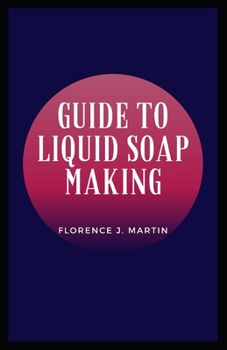Guide to Liquid Soap Making: Soap is a cleaning agent that is composed of one or more salts of fatty acids.
soap is a cleaning agent that is composed of one or more salts of fatty acids. Thus, by its broad definition, detergent is an umbrella term that includes soaps and other cleaning agents with various chemical compositions. Often, however, the term detergent is used in a narrower sense to refer to synthetic cleaning agents that are not soaps (that is, not salts of fatty acids). Conversely, the term soap is often used in a broader sense to include a variety of cleaning agents (such as "laundry soap"). Here, the term detergent will be used in its broader sense (to include soaps), and the term soap will be used for products that consist mainly of fatty acid salts.Detergents are commonly used in products for personal hygiene, dishwashing, and laundry. They are also used as ingredients in antiseptic agents, dry-cleaning solutions, lubricating oils, and gasoline.Although detergents are very useful, the excessive use of certain ingredients has led to adverse effects on the environment. For instance, phosphate additives used for water softeners led to an increase in phosphorus content in lakes and rivers, triggering algal blooms that in turn consumed most of the oxygen in the waters, killing fish and plants. Efforts have been made to reduce such negative effects, but the results have been mixed.The earliest known use of a natural, soap-like material was the powder of nuts from the Reeta (Sapindus) tree, a powder used by Indians since antiquity. In accordance with Ayurvedicteachings, Hindus in India were obliged to bathe at least once a day, every morning.The Babylonians used clay cylinders containing a soap-like substance, dating from 2800 B.C.E. A formula for soap-consisting of water, alkali, and cassia oil-was written on a Babylonian clay tablet around 2200 B.C.E.The Ebers papyrus (Egypt, 1550 B.C.E.) indicates that ancient Egyptians bathed regularly and combined animal and vegetable oils with alkaline salts to create a soap-like substance. Egyptian documents mention that a soap-like substance was used in the preparation of wool for weaving.It has been reported that a factory producing soap-like substances was found in the ruins of Pompeii (C.E. 79). However, this report appears to be a misinterpretation of the survival of some soapy mineral substance, probably soapstone, at the Fullonica where it was used for dressing recently cleansed textiles. The ancient Romans were generally ignorant of soap's detergent properties and made use of the strigil to scrape dirt and sweat from the body.The word "soap" (Latin sapo) appears first in a European language in Pliny the Elder's Historia Naturalis, which discusses the manufacture of soap from tallow and ashes, but the only use he mentions for it is as a pomade for hair. He mentions rather disapprovingly that among the Gauls and Germans, men are likelier to use it than women. According to one legend, "soap" takes its name from a "Mount Sapo" where ancient Romans sacrificed animals. Rain would send a mix of animal tallow and wood ash down the mountain and into the clay soil on the banks of the Tiber. Eventually, women noticed that it was easier to clean clothes with this "soap." The location of Mount Sapo is unknown, as is the source of the "ancient Roman legend" to which this tale is typically credited.In fact, the Latin word sapo simply means "soap." Borrowed from a Celtic or Germanic language, the term is cognate with the Latin term sebum(meaning "tallow"), which appears in Pliny the Elder's account. Roman animal sacrifices usually burned only the bones and inedible entrails of the sacrificed animals; edible meat and fat from the sacrifices were taken by humans. Under such circumstances, animal sacrifices would not have included enough fat to make much soap. The legend about Mount Sapo is probably apocryphal.
Format:Paperback
Language:English
ISBN:B08RR6YKPZ
ISBN13:9798588421119
Release Date:December 2020
Publisher:Independently Published
Length:94 Pages
Weight:0.26 lbs.
Dimensions:0.2" x 5.5" x 8.5"
Customer Reviews
0 rating





